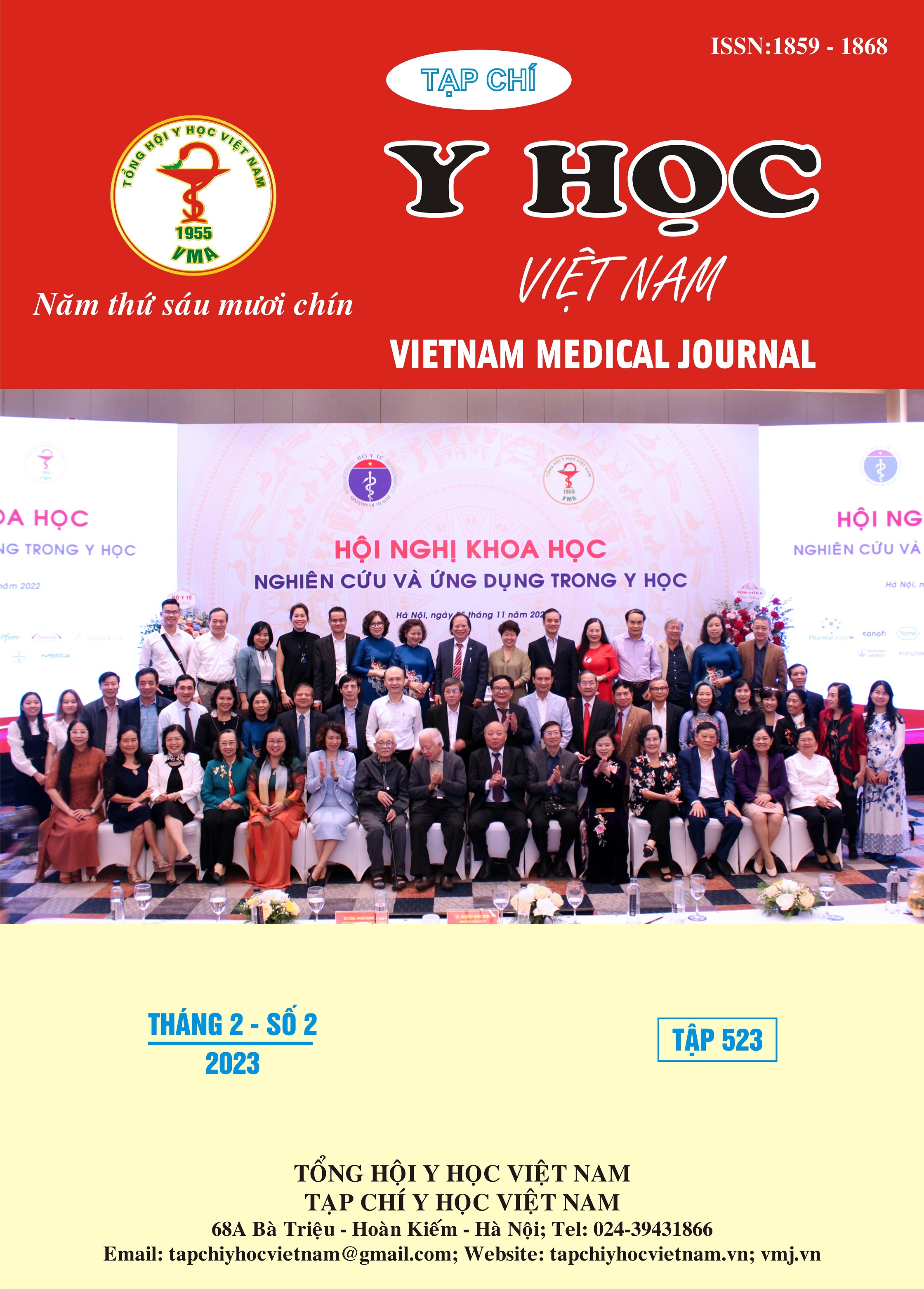EVALUATE THE OUTCOMES OF CEMENT AUGMENTATION PEDICLE SCREWS FOR PATIENT WITH LUMBAR-THORACIC OSTEOPOROSIS FRACTURE AT VIET DUC UNIVERSITY HOSPITAL
Main Article Content
Abstract
Purpose: The paper aims at describing clininal, paraclinical and evaluating the results of augmenting pedicle screws with cement towards patients having thoracic vertebrae injuries with osteoporosis. Methodology: Research elaborates on longitudinally prospective and retrospective observation of 34 patients diagnosed with having thoracic vertebrae injuries with osteoporosis, all of whom were carried out surgery in Viet Duc University Hospital from 06/2019 to 06/2022. Results: Among the 34 patients, male/female ratio = 1,62/1; mean age was 61,5 ± 13,2 years old. Most patients had symptoms of thoracic vertebrae aching (79,4%). Patients with nerve injuries intensity were mostly medium and mild (23,5%). Average pain level before VAS surgery was 6,3 ± 1,7. The average index for spinal function reduction before surgery among patients were 51,8 ± 12,3%, and among them were 61,8% that had lost most of their spinal function. The average T-score for the sample patients were -3,9 ± 0,6. The most frequently injured location was the chest hinge-lumbar area of 51,4%. The height of the spine decreased substantially before surgery, with an average front height (12,4 ± 1,8mm) and middle height (9,3 ± 1,7mm). The average kyphosis angle was 25,9° ± 4,0 degree, and the angle of kyphosis with the anterior part of surgery was 25,8° ± 4,3 degree. Using TLIC scale, the average score among patients was 4,65 ± 1,67. The average surgery duration was 107,9 ± 15,9 minutes, the average blood loss was 300,0 ± 96,9 ml and the average hospital occupation duration was 6,6 ± 1,8 days. Stroke during surgery with dural fracture was 2,9%, cement leakage outside vertebra was 5,9%. Medical complications after surgery witnessed 2,9% of patients getting inflammation at the surgical region and another 2,9% receiving urinary tract infection. The ODI after 1 month and 6 months all saw a considerable reduction and had a statistical implication of more than 99% (p=0,000<0,001, Paired Samples T-Test). The result from spinal grafting between kyphosis angle and kyphosis with the anterior was significantly lower compared to before surgery, which had a statistical implication of more than 99% (p=0,000<0,001, Paired Samples T-Test). Spinal height was also restored compared to before surgery after 1 month and 6 months, and had a statistical implication of more than 99% (p=0,000<0,001, Paired Samples T-Test). The quality of good and excellent living after 6 months according to Macnab scale was 94,1%. Loosening screw ratio after surgery was infinitesimal at 0,37%, and there were no case of breaking screws, pulling out screws, breaking rod or dislocating splints post surgery. Among the 34 sample patients, only 2 continuous vertebrae were damaged. After surgery, there were 94,1% of patients who received osteoporosis treatment. Conclusion: The result from augmenting fenestrated pedicle screws with cement surgery towards patients having thoracic vertebrae injuries with osteoporosis showed positive signs, with improved clinical and better orthopedic results. The risk of stroke during and after surgery was low and there was no significant complication.
Article Details
Keywords
cement augmentation pedicle screws, lumbar-thoracic vertebrae with osteoporosis fixation
References
2. Keiya Yamana, et al (2010), “Clinical application of a pedicle nail system with polymethylmethacrylate for osteoporotic vertebral fracture”, Eur Spine J (2010). 19:1643-1650.
3. Pinar Kuru, et al (2014), “Fracture history in osteoporosis: Risk factor and its effect on quality of life Rollins DL, Bernhard VM, Towne JB. Fasciotomy: an appraisal of controversial issues. Arch Surg. 1981; 116: 1474-1481.
4. Van Stata T.P., Leufkens H.G, Cooper C. “The epidemiology of corticosteroid-induced osteoporosis: a meta-analysis.” Osteoporos Int. 2002;13:777-787Nguyễn Hữu Ước, Vũ Ngọc Tú. Chấn thương, vết thương động mạch chi. Bệnh học ngoại khoa tập 1, Nhà xuất bản Y học; 2020.
5. Wang H., Li C, Xiang Q. (2012). “ Epidemiology of spinal fractures among the elderly in Chongquing, China”. J Care Injury.
6. Van Stata T.P., Leufkens H.G, Cooper C. “The epidemiology of corticosteroid-induced osteoporosis: a meta-analysis.” Osteoporos Int. 2002;13:777-787.
7. James S.Harop, et al (2004), “Primary and secondary osteoporosis incidence of subsequent vertebral compression fractures after kyphoplasty”. Spine J 29, 2120-2125


